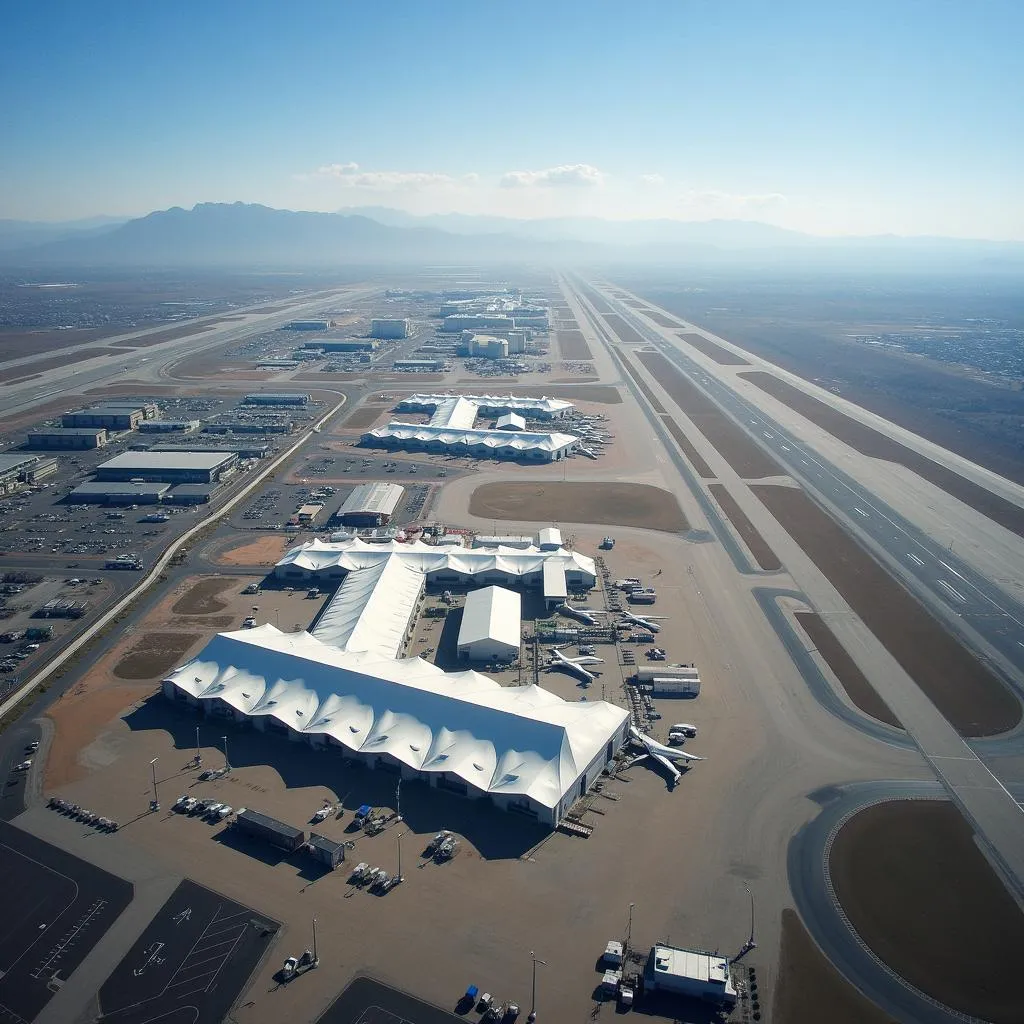The global aviation industry is a marvel of engineering and logistics, connecting people and places like never before. At the heart of this network lie airports, bustling hubs of activity that facilitate the movement of millions of passengers and tons of cargo daily. These intricate complexes are a testament to human ingenuity, and some have grown to truly staggering sizes. If you’ve ever wondered, “What are the 5 Biggest Airports In The World?”, prepare to be amazed by the sheer scale of these aviation giants.
Ranking the Giants: Measuring the World’s Biggest Airports
Before we dive into our list of the 5 biggest airports in the world, it’s important to understand how we’re defining “biggest.” While passenger count and aircraft movements are certainly factors, the most common metric used is total land area. This encompasses all the land owned and managed by the airport, including runways, terminals, cargo facilities, and even undeveloped land.
 Airport with largest land area
Airport with largest land area
The Top 5: A Closer Look at the World’s Biggest Airports
From sprawling deserts to bustling metropolises, these airports redefine what it means to be a global aviation hub:
1. King Fahd International Airport (DMM) – Dammam, Saudi Arabia
Land Area: Approximately 780 square kilometers (300 square miles)
Claiming the top spot by a significant margin is King Fahd International Airport, located near Dammam, Saudi Arabia. This behemoth boasts a land area larger than some small countries! While it doesn’t top the charts in passenger traffic, its sheer size reflects Saudi Arabia’s ambition to establish itself as a major player in the global aviation landscape.
2. Denver International Airport (DEN) – Denver, Colorado, USA
Land Area: Approximately 135.71 square kilometers (52.4 square miles)
Coming in at a respectable second place is Denver International Airport. Known for its iconic tented roof and rumors of underground bunkers, DEN covers an area larger than the island of Manhattan! Its spacious layout and efficient operations make it a favorite among travelers.
 Denver International Airport aerial view
Denver International Airport aerial view
3. Dallas/Fort Worth International Airport (DFW) – Dallas-Fort Worth, Texas, USA
Land Area: Approximately 69.63 square kilometers (26.88 square miles)
Texas does everything big, and Dallas/Fort Worth International Airport is no exception. As a major hub for American Airlines, DFW sees a massive volume of passengers and cargo traffic. Its sprawling layout includes five terminals and seven runways, making it a city unto itself.
4. Orlando International Airport (MCO) – Orlando, Florida, USA
Land Area: Approximately 53.83 square kilometers (20.78 square miles)
As the gateway to the Sunshine State and its many attractions, Orlando International Airport welcomes a significant number of tourists every year. Its expansive layout features four airside terminals connected by a central terminal building and an automated people mover system.
5. Washington Dulles International Airport (IAD) – Washington, D.C., USA
Land Area: Approximately 52.61 square kilometers (20.31 square miles)
Rounding out our list of the top 5 is Washington Dulles International Airport, serving the nation’s capital. Known for its iconic Eero Saarinen-designed main terminal, IAD has undergone significant expansions to accommodate its growing passenger numbers.
Beyond Size: What Makes a Great Airport?
While size is certainly impressive, it’s not the only factor that makes an airport great. Factors like efficiency, passenger experience, and connectivity also play a crucial role. For example, the biggest international airport in the world may not necessarily be the best in terms of passenger satisfaction. Similarly, an airport’s ranking on the [top 10 biggest airports in the world](https://airport-bbi.com/top 10 biggest airports in the world/) doesn’t guarantee a seamless travel experience. Recent events, such as the Sydney airport flash flooding today, highlight the importance of infrastructure and adaptability in the face of unexpected challenges. Ultimately, the “best” airport is the one that best meets the needs of its travelers and the demands of the global aviation network.
In Conclusion: A Testament to Human Ingenuity
These five airports are not just transportation hubs; they are engineering marvels and logistical triumphs that stand as a testament to human ingenuity. As air travel continues to grow in popularity, these giants of the sky will undoubtedly continue to evolve and expand, connecting people and cultures for generations to come.
For further assistance or information, please contact us at:
Phone Number: +13089626264,
Email: [email protected]
Or visit us at: 404 Bothwell St, Oxford, NE 68967, USA.
Our customer service team is available 24/7.

